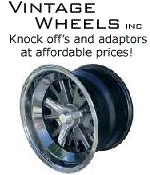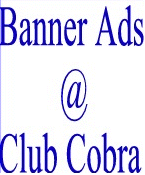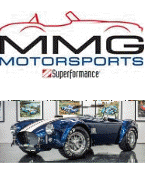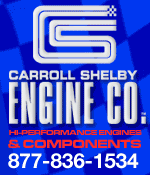 
 Main Menu
Main Menu
|
 Nevada Classics
Nevada Classics
|
 Advertise at CC
Advertise at CC
|
 January 2025
January 2025
|
| S |
M |
T |
W |
T |
F |
S |
| |
|
|
1 |
2 |
3 |
4 |
| 5 |
6 |
7 |
8 |
9 |
10 |
11 |
| 12 |
13 |
14 |
15 |
16 |
17 |
18 |
| 19 |
20 |
21 |
22 |
23 |
24 |
25 |
| 26 |
27 |
28 |
29 |
30 |
31 |
|
|
 CC Advertisers
CC Advertisers
|
|

12-20-2004, 08:12 PM
|
 |
Senior Club Cobra Member

|
|
|
Join Date: Jun 1999
Location: Fallbrook, CA USA,
CA
Cobra Make, Engine: Porsche 928 S4
Posts: 739
|
|

 Not Ranked
Not Ranked

Quote:
Originally posted by wrm
Me two, thanks. 
While I have many other suspension design books, I dont have Carrol Smiths, maybe someone can explain to me why Carrol Smith doesn't design anti-squat into an IRS. While I understand an IRS is limited to around 25%, surely 25% is better than none.
|
WRM,
Look, Carroll doesn't like it for the same reason that I do not like it. You cannot control the dynamics with mechanical leverage of this type.
The more you load the anti-squat/dive geometry in the chassis, the higher the resistance to motion without a basis of control.
As Bob stated, the transfer is nearly instantaneous and this is a out of control condition for a circuit type car.
One must control dynamics with wheel rates and dampers, not geometry lock ups.
Milesdw,
Quote "As you say, there is no way to increase weight transfer but anti-squat DOES increase rear tyre loading and thus traction. For an IRS anti-squat also has the benefit of minimizing any camber change due to suspension compression."
Well this is only partly true. On a perfect surface, one wishes 100% weight transfer. In a time frame that does not exceed tire spring frequencies. (Note: This is very important.) Load on a tire can only go so far before you exceed the available slip angle. Sidewall Hysteresis is also a consideration.
But in overall chassis design and setup for a road going or circuit type chassis and it's given application, any mechanical or geometrical binding is the wrong thing to introduce.
This is due to it not being controlled from a time based standpoint.
Transient behavior is the most difficult thing that a designer has to deal with in any chassis design.
And any anti squat-anti dive stuff just puts a chassis out there where you will never get it to work properly.
You do not need to take my word for it. Just read books by folks who have a clue. Or better yet, speak to some designers who are current in the art. |
-
Advertising


12-20-2004, 08:37 PM
|
 |
CC Member

|
|
|
Join Date: Jul 2000
Location: Las Vegas,
NV
Cobra Make, Engine: 427 SC
Posts: 1,076
|
|

 Not Ranked
Not Ranked
Richard, Bob
Nice info. Thanks for the posts.
427Sharpe, WRM,
Those uprights look like the aluminum ones Shelby used on the South African CAV sourced cars.
__________________
kris kincaid

|

12-20-2004, 09:30 PM
|
 |
CC Member

|
|
|
Join Date: Jun 2000
Location: Cape Town, South Africa/Mainz, Germany,
Posts: 1,601
|
|

 Not Ranked
Not Ranked
:-)
kris,
they are, but not many have been cast down here.
a similar pattern is available to me.
want some?
dominik
__________________
If I don't respond anymore, that's because I can't log in
|

12-20-2004, 10:05 PM
|
|
CC Member

|
|
|
Join Date: Nov 2001
Location: Bloomfield,
NY
Cobra Make, Engine: Modified FFR Cobra
Posts: 30
|
|

 Not Ranked
Not Ranked
Richard,
Thanks for explaining Carrol Smith's view on anti-squat, interesting stuff, I'll have to pick up his book and give it a read.
__________________
www.vpmcobras.com
|

01-04-2005, 11:15 PM
|
|
CC Member

|
|
|
Join Date: Dec 2001
Location: Yorba Linda,
ca
Cobra Make, Engine: B&B non-donor, 496 Genesis SO (608 HPwith 9.4:1 CR), Tremec TKO, Currier 8.8
Posts: 187
|
|

 Not Ranked
Not Ranked

I hope we are not all getting worked up for nothing. All suspension and geometry are always compromises. Y'all are saying what's better or worse... but for what? The dynamics of launching a 600 HP car off the line at the drag strip are different than the side, braking, and accelerating loads required of a road racer and different again than the requirements of an oval racer. Even the surface requres different suspension.
Look at the Dodges at the dragstips of the 60's with the rear wheels moved forward and weight moved behind the rear axle. They certainly aren't concerned about polar moments of inertia; they are only concerned about weight transfer during the launch. I've looked at pictures of the JBL chassis and I can tell you as an ex road racer, that thing looks trick.
I was wondering though whether the rear control arms are parallel unequal arms or non-parallel unequal arms. If they are parallel, they have the same weaknesses as the Jags and Factory Five IRS's - the camber will actually go positive on sag. Richard, if you're still lurking around, maybe you could answer.
Can't we all just get along?
Brian

|

01-05-2005, 11:03 AM
|
 |
Senior Club Cobra Member

|
|
|
Join Date: Jun 1999
Location: Fallbrook, CA USA,
CA
Cobra Make, Engine: Porsche 928 S4
Posts: 739
|
|

 Not Ranked
Not Ranked
Brian
Non-parallel unequal arms.
Parallel arms are a NO-NO on a mechanical grip type chassis.. For more reasons then Camber change. (Note, on a heavily Aero dependant type chassis, parallel arms have been used quite successfully by some folks.)
If you go to JBL Camber charts, you will see the camber numbers under load conditions. |

01-05-2005, 03:36 PM
|
|
CC Member

|
|
|
Join Date: Dec 2001
Location: Yorba Linda,
ca
Cobra Make, Engine: B&B non-donor, 496 Genesis SO (608 HPwith 9.4:1 CR), Tremec TKO, Currier 8.8
Posts: 187
|
|

 Not Ranked
Not Ranked
Richard,
You are absolutely correct. I just don't understand why so many use the parallel-armed Jag rear ends. If you have ever seen an XKE from the rear while cornering hard, they are really scary looking. The outside wheel looks like its at about +5 degrees camber.
Like your work.
Brian
|

01-05-2005, 04:21 PM
|
|
CC Member

|
|
|
Join Date: Nov 2003
Location: New Britain,
CT
Cobra Make, Engine: Size 10 Feet
Posts: 3,019
|
|

 Not Ranked
Not Ranked
Actually, the Jag's theoretical swing axle radius is within contemporary standards - just over the track width. It will compensate about 45% for roll camber change. Probably a good compromise. If you have 2 degrees roll with a static camber of -3/4 degrees (stock setting), you'll end up with +1/2 degree at maximum (street) G force. A shorter swing axle radius will make the rear end very sensitive to chassis height change due to power squat or brake rise.
 |

01-05-2005, 07:10 PM
|
 |
Senior Club Cobra Member

|
|
|
Join Date: Jun 1999
Location: Fallbrook, CA USA,
CA
Cobra Make, Engine: Porsche 928 S4
Posts: 739
|
|

 Not Ranked
Not Ranked

Bob,
How bad are the jacking effects with the Jag geometry?
I have always wondered about the lower arm angle and what the jacking forces are.
Now, to be honest, Jags are some of the finest behaved chassis that there are.
The JBL theoretical swing axle radius on the rear is a bit longer than what you show (Close to 345 inches.) and the front is 120 inches. (I really like long moment arms to slow down the dynamics.)
The Front RC is "0", the rear ".625" at normal ride height. I also like a pretty flat Roll axis with this CG and weight distribution. (45/55.)
Also, the angles are such that no jacking effect is implied under roll conditions.
I have found this combination to work fairly well and produce the dynamics that I desired for this chassis.
It is not at all what I would do for a Aero car. But for this type of application it seems work OK. My wheel rates can remain low, damping rates in the 250's and then roll rates control the rest.
But as we both know, there are many ways to skin the cat.
|

01-05-2005, 08:35 PM
|
|
CC Member

|
|
|
Join Date: Dec 2001
Location: Yorba Linda,
ca
Cobra Make, Engine: B&B non-donor, 496 Genesis SO (608 HPwith 9.4:1 CR), Tremec TKO, Currier 8.8
Posts: 187
|
|

 Not Ranked
Not Ranked
strictlypersonl
Quote:
|
you'll end up with +1/2 degree at maximum (street) G force
|
I certainly don't want to be argumentative, but I have found that on a real racetrack in a front engined race car, anything less than about 2 1/2 degrees negative camber just won't get power to the ground and will heat up the outer edge of the outside rear tire. We used to start with 1 1/4 degrees static and go up from there while cornering.
The Nascar boys bend the straight axles 3/4 degrees negative.
Anyway, as Richard sez: "There's more than one way to skin a cat".
Brian |

01-07-2005, 05:24 AM
|
|
CC Member

|
|
|
Join Date: Nov 2003
Location: New Britain,
CT
Cobra Make, Engine: Size 10 Feet
Posts: 3,019
|
|

 Not Ranked
Not Ranked
Brian,
I was careful to describe the behavior as street, not track. G force with street tires and springs will be under .9 typically. Race tires might bump that up to 1.5 G, so the camber figures that I state won't apply to the race track. Race tires like a bit of negative camber to compensate for sidewall flex, so I'm not surprised that race cars have such high negative camber. But - I wouldn't want to run high static negative camber because of tire wear and tracking problems.
---------------------------------------------------------------------
Richard,
I was afraid of the jacking effects too, so in our setup, I lower the rear roll center a bit with shorter springs and modified top damper mount. Our static (street) roll centers are still a bit higher than yours but they come down to similar heights when the car is lowered for the track.
|

01-07-2005, 01:12 PM
|
|
CC Member

|
|
|
Join Date: Dec 2001
Location: Yorba Linda,
ca
Cobra Make, Engine: B&B non-donor, 496 Genesis SO (608 HPwith 9.4:1 CR), Tremec TKO, Currier 8.8
Posts: 187
|
|

 Not Ranked
Not Ranked
At the risk of hijacking this thread (sorry Dom), Strickly and Richard seem to be all over this stuff. I am not sure I have seen a more knowledgeable and respectful discussion on this or any subject in a while.
If I hafta, hafta, hafta run a live axle (for reasons beyond this discussion), what do you guys think of 3-bar setups? As I see it the biggest advantage is the ability to use a much longer top link, i.e. you can run it down the tunnel.
Also, what do you think of the torque arm setup ala Gen 4 Camaro/Firebird?
Thanks,
Brian
|

01-07-2005, 02:21 PM
|
|
CC Member

|
|
|
Join Date: Nov 2003
Location: New Britain,
CT
Cobra Make, Engine: Size 10 Feet
Posts: 3,019
|
|

 Not Ranked
Not Ranked
Quote:
Originally posted by bmcmillan
...
Also, what do you think of the torque arm setup ala Gen 4 Camaro/Firebird?
Brian
|
At the risk of showing my ignorance of domestic cars, does the Camaro use something like a torque-tube?  |

01-07-2005, 04:29 PM
|
|
CC Member

|
|
|
Join Date: Dec 2001
Location: Yorba Linda,
ca
Cobra Make, Engine: B&B non-donor, 496 Genesis SO (608 HPwith 9.4:1 CR), Tremec TKO, Currier 8.8
Posts: 187
|
|

 Not Ranked
Not Ranked
This torque arrangement consists of an arm is connected to the rear end at one end and the transmission crossmember at the other. This arm is firmly fixed to the read end in two places, thus preventing rotation of the rear end. The rear end is located longitudinally (fore and aft?) by lower control arms like any four-bar system.
I'm not sure I splained it very well, but it actually works quite well. I used it in a Cobra. It worked really well on the street. I didn't get a chance to try it on a track because the car got stolen with only 500 miles on it. I used to race Camaros in SCCA (American Sedan class) and this setup worked well for a long, heavy car. I'm not sure if it would work well for a Cobra because of the anti-squat characteristics. The anti-rotational forces push up at the center of the car, rather than the rear, causing the whole car to rise theoretically, rather than just the rear. You guys are up on the theory of this stuff. What do you think?
|

01-07-2005, 07:00 PM
|
|
CC Member

|
|
|
Join Date: Oct 2000
Location: Canandaigua,
NY
Cobra Make, Engine: FFR2521
Posts: 10
|
|

 Not Ranked
Not Ranked
Making assumptions on the knuckle dimensions, and using a CG height of 18", I came up with around 100% anti-squat.
I have seen GT 40s with their lower arms at a similar high angle. It must have been a design preference in those days.
Craig
__________________
www.vpmcobras.com
|

01-07-2005, 07:03 PM
|
|
CC Member

|
|
|
Join Date: Oct 2000
Location: Canandaigua,
NY
Cobra Make, Engine: FFR2521
Posts: 10
|
|

 Not Ranked
Not Ranked
Also, side view swing arm length is around 75 inches.
Craig
__________________
www.vpmcobras.com
|

01-07-2005, 07:11 PM
|
|
CC Member

|
|
|
Join Date: Mar 1999
Location: penn.,
Posts: 2,559
|
|

 Not Ranked
Not Ranked
Didn't the 60s vintage GT40 and coil spring Cobra use the same rear uprite. Also ,I would have sworn I heard one of the TV commentators say that the Dyson team was still using the 60s GT40 basic chassis design.
|

01-07-2005, 07:48 PM
|
|
CC Member

|
|
|
Join Date: Nov 2003
Location: New Britain,
CT
Cobra Make, Engine: Size 10 Feet
Posts: 3,019
|
|

 Not Ranked
Not Ranked
The GM-style torque arm makes for an elegant design but the short length makes for too much anti-squat unless you can place the front mount very low and as far forward as possible.
IMHO, the most important factor when optimizing a solid axle for handling is keeping the roll center low and stable.
Something I did a long, long time ago on a race car, that I haven't seen done again: A Watts link attached to the bottom of the differential, pivoting in a horizontal plane. The roll center was about 5" high. It worked amazingly well.
The layout of the GT and Cobra uprights were similar but they were completely different pieces. The geometry between the two cars was pretty close though, in spite of the different layout of the trailing arms. In both, the top arm (or its equivalent) was close to horizontal, with the lower assembly slanting up at about 6 degrees, probably for anti-squat/lift.
|

01-07-2005, 08:39 PM
|
 |
Senior Club Cobra Member

|
|
|
Join Date: Sep 2000
Location: Holderness, NH, US of A,
NH
Cobra Make, Engine: CSX 4772 old iron FE
Posts: 5,499
|
|

 Not Ranked
Not Ranked
I'm looking at the bushing set up for the rear lower inner pivot point (back to the original car and post, sorry). It looks like the amount of anti-squat is controlled by the tension you crank that inner bush to with what looks like a pipe nipple with a nut on each end of the bush material.
|

01-08-2005, 05:42 AM
|
|
CC Member

|
|
|
Join Date: Oct 2000
Location: Canandaigua,
NY
Cobra Make, Engine: FFR2521
Posts: 10
|
|

 Not Ranked
Not Ranked
In theory, the amount of anti-squat is solely from the angle of the upper and lower arms which dictates your Instant Center location and Side View Swing Arm Length. The bushing pictured will need to flex, so it either has to be rubber or, better yet, a spherical bearing.
It looks like you could stiffen that bushing by increasing the tension with those nuts, but that would have no affect on the geometrical anti-squat. But maybe creating a physical bind in the suspension to limit squat is an acceptable practice? Most likely not.
Craig
__________________
www.vpmcobras.com
|
 Posting Rules
Posting Rules
|
You may not post new threads
You may not post replies
You may not post attachments
You may not edit your posts
HTML code is On
|
|
|
All times are GMT -7. The time now is 07:51 AM.
|



















 Linear Mode
Linear Mode



